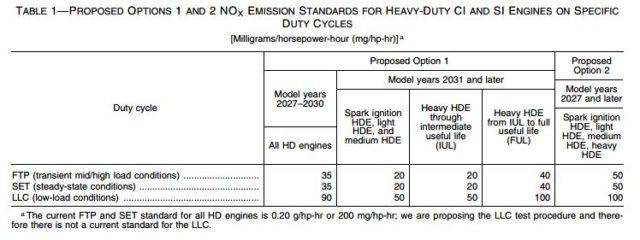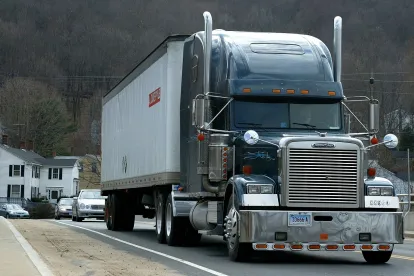In our last blog post on this topic, we covered US EPA’s Cleaner Trucks Initiative, the California Air Resources Board’s (CARB’s) heavy-duty engine and vehicle omnibus regulation, and CARB’s Advanced Clean Trucks Regulation.
US EPA Heavy-Duty Highway Vehicles Proposed Rule Comment Period Ends
For the on-road heavy-duty trucking industry, US EPA finally issued its long-awaited proposed rule on March 7, 2022 for heavy-duty highway vehicles and engines beginning in MY 2027. Heavy-duty highway vehicles are generally those in weight categories ranging between 8,500 lbs to greater than 33,000 lbs GVWR. The comment period recently ended on May 13, 2022. This rule, entitled Control of Air Pollution from New Motor Vehicles: Heavy-Duty Engine and Vehicle Standards, 87 Fed. Reg. 17414 (March 28, 2022), is the first step in EPA’s “Clean Trucks Plan.” As identified in President Biden’s Executive Order 14037, Strengthening American Leadership in Clean Cars and Trucks, EPA intends to issue a series of regulations over the next three years to reduce pollution from trucks and buses and to advance the transition to a zero-emissions transportation future.
Generally, the primary regulatory actions that make up the proposed rule include: (1) stronger NOx standards beginning in model year 2027 with either immediate implementation or an incremental increase in stringency; (2) stronger useful life periods; (3) longer warranty periods to increase the number of useful life miles covered under warranty; (4) tightening of “Phase 2” GHG standards for model year 2027 for 17 of 22 subcategories of vocational and tractor vehicles (e.g., school buses, commercial delivery trucks, short-haul tractors); and (5) setting of stronger emissions standards for medium-duty commercial vehicles (e.g., commercial pickup trucks and vans) for model year 2027 onward.
Specific to NOx emissions standards, the proposed rule outlined two primary options for industry to provide comments. Using light and medium heavy duty engines as an example, Option One would include a phased approach of 35 mg/hp-hr for FTP/SET (transient and steady-state conditions) from 2027-2030 with a decrease to 20 mg/hp-hr for 2031 and beyond. Option One would also have a LLC (low-load conditions) standard of 90 mg/hp-hr for 2027-2030 decreasing to 50 mg/hp-hr NOx for 2031 and beyond. Option Two would include a more generous 50 mg/hp-hr for FTP/SET and 100 mg/hp-hr for LLC for MY 2027 and beyond. Finally, EPA also introduced an alternative option with a combination of more stringent emission standards but increased useful life and requested comment on feasibility for implementation in MY 2027.

Source: 87 Fed. Reg. 17414, 17422 (March 28, 2022).
As part of its extensive comments on the rule, CARB identified Option One as the option that “most closely conforms” with the agency’s previously finalized Omnibus regulation in December 2021. CARB explained the “proposed Option 1 NOx and PM standards are identical to CARB’s Omnibus standards for MYs 2031 and later HDEs.” CARB further recommended modifications to extend this consistency to MY 2027-MY 2030, such as adopting a 20 mg/hp-hr NOx on FTP/SET and a 50 mg/hp-hr NOx on LLC for light and medium HDEs through useful life and heavy HDEs through intermediate useful life. Other related recommendations from CARB included making clean idle NOx requirements mandatory, including the Option 1 PM, HC, and CO standards in the final rule, and closing crankcase ventilation systems.
Although primarily focused on on-road, the rule did provide a groundwork for future amendments to nonroad engines as well, including certification of deterioration factors and simplification of annual reporting. US EPA plans to propose amendments in a future rulemaking to align nonroad regulations with maintenance-related provisions adopted in this rule. The proposal also includes amendments regarding the confidentiality of certain information submitted to EPA for engines, vehicles, and equipment and amendments to regulations that implement EPA’s air pollutant emission standards for other sectors (e.g., light-duty vehicles, marine diesel engines, locomotives, various types of nonroad engines, vehicles, and equipment).
We will continue to monitor updates on the final rulemaking, and it remains to be determined whether CARB and EPA will reach harmonized standards for the heavy-duty trucking industry.
CARB Rulemaking for Off-Road Diesel Engine Regulations
CARB is currently working on potential amendments to its off-road diesel engine standards in its Tier 5 rulemaking – laying a groundwork for future harmonization questions with federal standards. These new standards will be up for CARB consideration in 2024-2025 with planned implementation in 2028-2029. Although CARB has not released a formal proposed rule, it has held two workshops detailing the potential amendments to diesel off-road emission standards.
The first workshop was held on November 3, 2021 and provided a rulemaking overview for the off-road Tier 5 rulemaking. Specifically, it discussed federal preemption, proposed emissions standards for criteria pollutants, proposed certifications, and a manufacturer-run off-road in-use testing program. The second workshop took place on May 2, 2022 and discussed the Tier 5 workgroup’s in-use concepts.
Federal Preemption
CARB is advocating for US EPA to cooperate with its Tier 5 rulemaking process, which would increase consistency with aligned standards and reduce the risk of circumvention of the state’s Tier 5 standards through purchase of out-of-state equipment. This is because only EPA can set emissions standards for farm and construction equipment with engines less than 175 horsepower (130 kW) under 40 CFR § 1074.10. Examples of preempted equipment include backhoes, pumps, compressors, skid steers, excavators, and wheel loaders.
Emissions Reduction
The agency has proposed the following potential changes for criteria pollutants with respect to the existing Tier 4 Final standards:
-
Up to 75% reduction in NOx and PM for diesel engines
-
90%/75% reduction in NOx/PM for engines 56
-
50% reduction in NOx and PM for engines >560 kW
-
No changes for NMHC and CO
-
Equipment
For example, the current NOx standard for engines > 560 kW is 0.40 g/kW-hr. A 50% reduction would create a more stringent NOx standard of 0.20 g/kW-hr.
CARB is also considering a CO2 tailpipe standard for off-road diesel engines targeting a 5-8.6% reduction using the Southwest Research Institute (SwRI) demonstration project’s engine, John Deere 6068 (6.8 L, 187 kW @ 2200 rpm), as a baseline. If passed, these would be the first greenhouse gas (GHG) standards for off-road diesel engines in the United States.
Certifications & In-Use Testing Program
Neither CARB nor US EPA have a low load cycle for off-road engines. According to CARB, SwRI data show NOx emissions from their proprietary Low Load Application Cycle (LLAC) are up to 19 times higher than NOx emissions from the NRTC used to certify off-road engines. CARB requested feedback on whether SwRI’s LLAC can serve as an off-road certification cycle to ensure emissions are controlled during low load off-road operation.
CARB also requested stakeholder feedback on (1) a manufacturer-run in-use testing program for off-road diesel engines; (2) demand for a dedicated off-road hybrid powertrain certification; (3) increasing useful life; (4) lengthened minimum warranty periods; (5) idling restrictions for off-road diesel engines; (6) selective catalytic reduction concepts; (7) on-board diagnostic requirements for off-road engines; (8) need for additional flexibility allowances; and (9) improving averaging, banking, and trading recordkeeping and reporting requirements to better track family emission limits.
CARB’s second workshop detailed proposed changes to its Off-Road In-Use Compliance (ORIUC) Program via a manufacturer-run Off-Road In-Use Testing Program (ORIUT). This program has three phases: (1) an initial screening phase consisting of engine control units (ECU) and sensor data; (2) a second phase using a Portable Emissions Measurement System (PEMS) for engine families that fail the initial screening; and (3) corrective action, if necessary. After manufacturers submit emissions data, CARB will bin (categorize) the data as idle, low load, or high load bins.
CARB also requested feedback on (1) alternative manufacturer-run concepts; (2) whether a sensors-based program would be attractive to industry; (3) defining bins for sensors reporting; (4) standardization of ECU communication; (5) onboard diagnostics or in-use emissions testing applied to off-road engines; and (6) in-use emissions data evaluation methods.
We will continue to monitor CARB’s development of the Tier V standards as they evolve.





 />i
/>i

